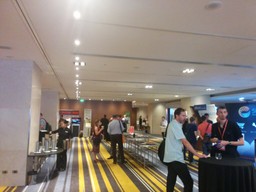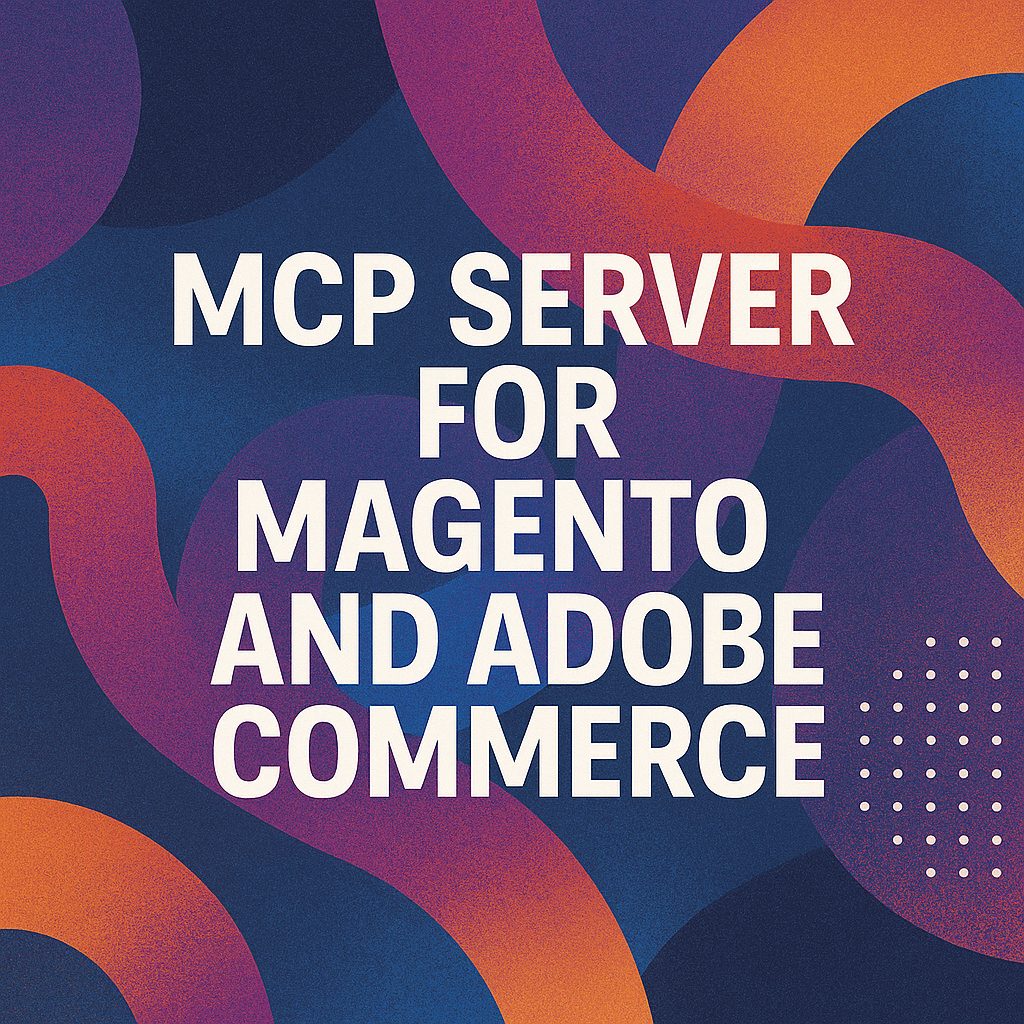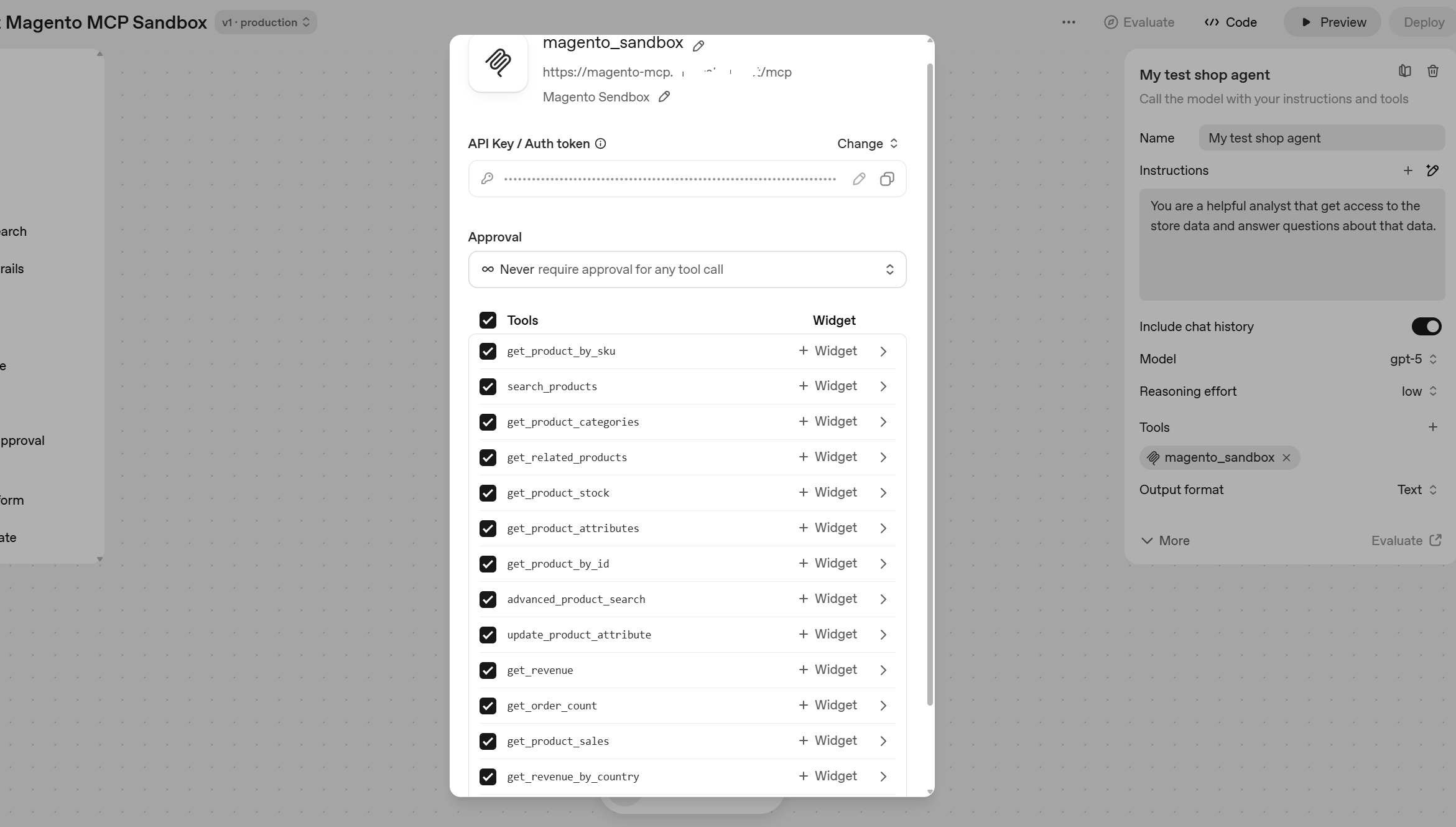
Magento Live Australia 2014, exhibition area
Last Friday night I returned from the biggest Magento event in Australia – Magento Live Australia 2014. While the event is fresh in my memory, I decided to write short notes about this great conference. I’ll make it in the form of a diary in chronological order.
Magento Live Australia Day 1, Nov 13, 2014
Magenable is based in Melbourne, so to attend the conference we had to take a flight and arrived to Sydney a bit after it has started, 11 am.
The venue
Magento Live Australia 2014 was organized at Hilton Sydney, right in Sydney CBD. The place was easy to find and it took us around 30 minutes of drive from the airport to get there.
The quality of the venue was very good, a kind of level you expect from high-class hotel. Magento Live events were distributed between two levels (3 and 4), which was a slightly inconvenient, but not a big deal. The food and drinks served in Hilton during the event were good and the service was decent. The only hiccup I’ve noticed was a broken male toiled on the 2nd day.
But that’s enough about the venue, back to the topic.
Magento Multisite Planning
The 1st presentation we’ve managed to attend (from the middle) was a Magento U seminar by Ben Marks. I personally have taken corresponding Magento U course online, but anyway it was very good to hear this topic presented by Ben, who is a recognised subject matter expert. If you plan complex multisite Magento deployment – a great piece of knowledge.
Commersations
The next session I’ve attended after lunch break was called “Commersations with the Magento Team”. Yes, this isn’t a typo, “commersation” is a new word seems to be invented by Magento guys and stands for interchange of ideas, thoughts and discussions on commerce. There was a great mix of retailers and vendors in the room, split into 6 or 8 tables and discussing topics like “What Magento features do you miss the most?”, “What are the hot trends in eCommerce?”, It was a good experience, but for the future I would suggest to make a bit smaller groups, it is a little bit hard to keep common discussion in a group of 10-12 people. Also, probably a facilitator for each group can help make the talk more effective. Nevertheless there were some interesting ideas talked through including export-import issues and organization of complex promotion rules.
Technology start-ups success stories
The last presentation I’ve attended Thursday was about building new businesses (related at some extent to eCommerce and specifically Magento). There were presentation from four people – two merchants and two technology partners of Magento/eBay:
- Alex Podopryhora from M2E Pro, the most popular service (with Magento extension) to integrate online stores with eBay, Amazon and Rakuten;
- Sarah Timmerman from Beginning Boutique, pure-play online fashion retailer;
- Krisztian Panczel from Cheap Sheds, like you may guess his business is to sell sheds online;
- Carl Hartmann from Temand0, a software solution to streamline shipping, working with multiple carriers, naturally has Magento integration
It isn’t easy at all to start a new business and good to see when entrepreneurs who succeeded in this journey share some secret source of their success, here are just few notes I’ve found most interesting:
- Don’t be very discouraged if you are not the 1st on the market – Google wasn’t the first search engine, Apple wasn’t the first smartphone and M2E wasn’t the 1st extension to integrate Magento store with marketplaces like eBay;
- Cash is the king. There may be situations where your profit looks great on the paper, but you have no cash in bank to pay the bills in time and to resolve emergency issues, so control your cash flow, plan ahead and have a cushion, It may sound obvious, but many entrepreneurs, especially without financial background were really burnt there;
- If you don’t ask for help you’ll not get it, try to learn from others, it is faster, cheaper and less painful. Don’t be shy, you’ll be surprised how many successful entrepreneurs are ready to pay back to the community and provide you with at least an advice or feedback that can save you time, money and nerves;
- Be persistent, but flexible. It’s a fine balance there, you need to have both qualities to succeed;
- Finally – if you are an merchant and have ambitious plans – use Magento as a flexible and customizable platform with great ecosystem (developers, solution partners, technology partners). Both Krisztian and Sarah have tried number of other platforms before Magento and know what they are talking about.
Casino party
A great day was concluded by a great party in “The Ivy Sunroom”, few blocks away from Hilton. Aside of mingling and drinking the attendants were given a chance to play in casino. I was quite lucky with my casino, ended up having 3x more virtual money than at the start and bought few lottery tickets (that is where you could spend virtual money). Unfortunately it didn’t bring be a lottery main prize – participation in the next biggest Magento event – Imagine 2015 in Las Vegas. Nevertheless, I had a good fun, kudos to organizers and sponsors.
Magento Live Australia Day 2, Nov 14, 2014
Magento 2
For me the 2nd conference day started from the session dedicated to Magento 2. There was very interesting competing marketing stream and I had real problems to decide where to go, but finally went to Magento 2. The presentation was given by three guys from eBay/Magento – Paul Boisvert (Director of Product Management), William Harvey (Principal Product Manager) and Rick Hogge (Senior MTS Architect). Slideshow below shows some fragments of Rick’s presentation.






Here are the main takeaways from the presentation:
- Magento 2 dev beta is scheduled to be ready in 5 weeks. Again a delay (I believe it was planned to be ready November 2014), but not so big. If I’ve counted correctly the release should be published Dec 19, 2014 at GitHub. I really hope that Magento guys will deliver on this promise;
- Magento 2 will use new stack of technologies (check one of the slide in the slideshow), but not the very latest ones, the stability is a priority;
- Magento 2 will be faster – there will be native support of nginx, full page cache (Redis, Varnish) among other ways to provide speed improvements;
- Magento 2 will use Zend 1 framework;
- Installation of extensions will be significantly improved;
- The testing will be easier with Magento 2 testing framework (already available at GitHub);
- Development and customization will be easier than now due to improved solution architecture, like better organization of the code, layouts and more genuine support of MVC;
After exciting news about Magento 2, there was a time for Magento Pitchfest. There idea here was to pitch a new feature for Magento. I think that this part can be better organized – the announcement/call for pitches should be done (or done more prominently) ahead of the conference, so people can think about what to pitch. We have heard just 3 pitches:
- James/Balance Internet pitched contractual pricing support;
- Jonathan/Aligent pitched an idea of multiple warehouse/multiple inventory;
- Finally there was a funny pitch about applying moustaches across different elements of Magento (I’ve missed the name of the guy who proposed that feature).
The winner was Jonathan from Aligent.
General Session
After refreshment break there was a general session (no alternative) where folks from Magento talked about their view on the market and where and how Magento/eBay plans to go. Something to note from these presentations:
- Magento has great progress over the last year – it now has 30% share among Alexa Top 100K websites globally and 45% in Australia and progressed to Challengers in the latest Gartner research of top 11 ecommerce platforms;
- Magento ecosystem consists of 300+ solution partners, 6,000+ third party extensions, 3,500+ Magento certified developers
- Spinning off Paypal is good for Magento, it will get more attention from eBay top management and the decision-making chain will be streamlined;
- Magento CE 1.9.1 and Magento EE 1.14.1 were just released with number of great features (support of PHP 5.6 and MySQL 5.5, better default responsive themes, Google Universal Analytic support, Magento EE 1.14.1 will also have built-in Visual Merchandising tool (used to be an extension from OnTap);
- eBay confirmed commitment to keep Magento as open-source platform in line with such great industry example as Sun/Oracle – MySQL
Here is a slideshow with few photos from general session:




B2b Commerce in a B2C world panel discussion
Jerome Green (Atdec) and David Short (Shorty’s Liquor) shared there experience about building B2B solution based on Magento and complication of having both B2B and B2C business. The most important takeaways I’ve got from this discussion are listed below:
- It may be complicated to introduce direct B2C channel if you used to work only through retailers/distributors, but it is possibly to do it right. Especially sensitive issue here is pricing;
- Having B2C direct channel is very important and not only as an additional source of revenue, but also to be closer to final customers (and understand them better) and from branding prospecive;
- Integration of all internal IT systems (online store, ERP, CRM) is a complex job and it is important to have the right trusted partner there who can handle this job for you;
- From David’s experience it is very useful to have in team an experienced and trusted independent consultant, not employed by any vendor to do proper scoping and control your implementation partner along the way (if you need one contact me, this is a service that Magenable provides);
- B2B clients value personalisation and special workflow that is comparatively easy to build with Magento-based online B2B store;
Breakout Session 2 – eCommerce in Asia and interview with Gary Wheelhouse from Harvey Norman
The final session of the conference that I attended was started by Tim Lee from Singpost. Singpost is more than just post now, includes logistic and supporting services and serves client across many Asian countries, so Tim has good experience to share. He has talked about what is the best place to start to conquer Asian market. According to Tim:
- China is the biggest market and may be a right choice to start. However, it isn’t easy – the market is really huge and complex, you need to have solid experience and resources to tackle it right;
- He doesn’t recommend to start from 2nd biggest market (Japan) and South Korea, because these market are very mature, has high ecommerce penetration and in general quite hard for new entrants;
- India is the second biggest country in the Asia and the whole world, but ecommerce there is very underdeveloped and it is probably the hardest market due to luck of infrastructure complex regulations (including currency) and very high level of returns – Tim quoted 46% rate of returns on delivery;
- Sweet spots from where you should start your Asian operations according Tim are Malaysia and Singapore. Maybe he has a bit biased opinion (since he is from Singapore), but anyway, something to consider
Next part of session was an interview with Harvey Norman Chief Digital Officer Gary Wheelhouse. Harvey Norman brought rather big team to Magento Live, I’ve counted probably around 5 people around. Several things from the interview that I’ve found most interesting:
- Live support is very important functionality, Harvey Norman recruited there people who actually worked on the floor and constantly train them;
- Harvey Norman was rather late entrant, they launched in 2011 and Gary is happy that they had mobile/responsive rendering of the website quickly. There was doubts and resistance regarding having that as a priority, but appeared that it was a right move that brought the company millions of dollars in revenue;
- Having support from different groups of stakeholder in big organization is a key to digital initiatives success and it was the hardest part;
- User research is a key to build a right solution, without research and numbers all you have are just opinions
That was the end of official part of the conference, afterwards there were cocktails and finally another party sponsored by eWay, which we had to leave earlier to catch a plane back to Melbourne.
Conclusion
I’ve enjoyed taking part in Magento Live Australia – it was really useful for keeping in touch with what’s going on in wider Magento ecosystem and what should we expect from both technical and organisation points of view. Equally important was to have an opportunity to network with people meet those you knew before (maybe only virtually) and new ones.
If you took part in the event and noticed that I’ve missed something important – feel free to add your comment.
I also have to ask to excuse me for not perfect photos – they were taken on smartphone in limited light.
Updates
- 26/11/2014 Magento published photos from the conference, much better than mine, you can check them on Flickr
- 26/11/2014 Presentations are available for view at Magento Live Australia 2014 website
- 29/11/2014 I have found another Magento Live Australia 2014 wrap up from Sid Young (Cynetix)





